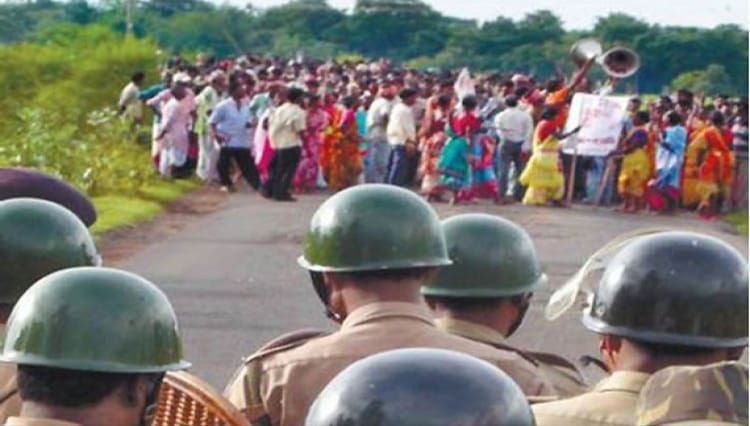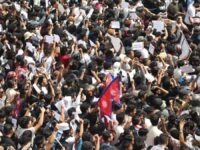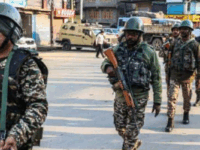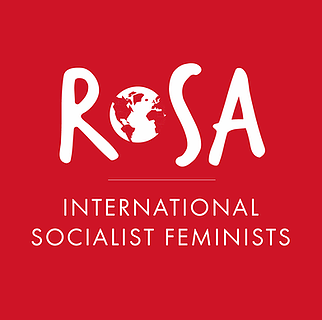How Stagism Led To The CPM’s Betrayal Of Workers

Ever since Karl Marx and Friedrich Engels developed their philosophy and theory on communism, the task of how to actually develop a communist society in the real world has been one that has challenged intellectuals and political leaders alike – on a theoretical as well as practical level. The various attempts to establish communism in the 20th century are a testament to the breadth of the task at hand. Rome was not built in a day, after all, and communism certainly won’t appear out of thin air the day after a working class revolution succeeds. But as a single butterfly can cause a cyclone, small differences in opinion play out as major issues in the development of Marxist parties and their programs. The history of India attests to this, as exemplified by the failure of the West Bengal Left Front government, and the current mistakes of the Kerala Left Democratic Front.
Marx described socialism, or more accurately the socialist mode of production, as a historical phase of economic development, where production was done for human needs (use-value) rather than profit, in a highly planned economy. As it was a historical phase of development, it would bear the hallmarks of the society or economic system it emerged from, which was the capitalist mode of production. The internal contradictions within capitalism would lead to its own downfall. The key factors which enabled the possibility of a socialist society out of a capitalist one were the increase in productivity and technology (which would lay the foundation for the abundance that would sustain a socialist society), and the formation and subsequent radicalisation of the working class – a process called proletarianisation – who would then rise against the capitalist class and take control of society.
Marx also envisaged the transition from a capitalist to a socialist society in political terms as a ‘dictatorship of the proletariat’, a way of saying that the proletariat would assume state power and create policies and decisions in its interest (much like the capitalist class does under capitalism), which would lead to the eventual establishment of a higher level of communism, one where class distinctions, along with money and the state itself, disappear.
Following that line of reasoning, it would have been natural to expect that the first place for communism to take hold would have been one of the more advanced capitalist economies of the time, and Marx himself felt that Germany (did he?) would be one of the foremost candidates for this to happen. (This was a sentiment that, as we shall see, was echoed by Vladimir Lenin.)
However, history does not follow a playbook, the first place where the working class successfully carried out a revolution and seized power was the backwards, semi-feudal Russian Empire. This was the largest contiguous empire in the world, and was an economy dominated by peasants (individual producers) and ravaged by wide scale profiteering and imperialist plunder, not to mention being worn down by years of war, first the World War then followed up by the Civil War after the Tsar was overthrown and the Bolshevik party took power.
In this situation, how exactly would the transition to socialism take place?
During the Civil War, the extreme circumstances of having to defend the world’s first ever workers’ state in a country devastated by the First World War led to the Bolsheviks adopting a policy informally termed “War Communism” which meant needing a highly centralised state apparatus with policies such as nationalisation of all industries with strict centralised management, state control over foreign trade, and extreme measures such as forbidding strikes, requisitioning surplus grain from peasants, rationing of food and most other commodities. This was successful in sustaining the Red Army and winning the War, but some of the extreme measures were unsurprisingly unpopular and led to revolts. War communism had outlived its usefulness.
This was the setting for Lenin to introduce the New Economic Policy in 1921, now that the Soviet Union was confronted with the task of building socialism in the here and now rather than in the distant future. The problem was the one we pointed out earlier, that Russia was a backward country predominated by agriculture, which was still in private hands (with the peasantry). Until this sector could be collectivised under the leadership of the proletariat, the task of building socialism could not be completed. But in order to get there, there needed to be a sharp uptick in agricultural productivity, the collectivisation of agriculture was neither popular nor feasible at that point. As the Soviets had state power, and the proletariat was in alliance with the millions of small peasants, Lenin envisaged a “state capitalist” period in the Soviet Union which would lay the material basis for socialism in the country. Lenin compared it with Germany, which was “state capitalist” insofar as the state was highly centralised and concentrated, but crucially subjugated by capital and the capitalist class.
The NEP sanctioned the co-existence of private and public sectors, permitted foreign investment in order to spur industrial and technological development, and opened up markets to a greater degree of free trade. Its aim was to develop a collective agricultural sector by stimulating grain production by allowing a limited grain market. Another crucial point to mention here is that this was required not just because of the ultimate aim of building socialism, but also to be able to defend the country in the event of another war, as they were “encircled” by hostile capitalist powers. Lenin and Trotsky had hoped in their time that the revolution in Russia would spread to the more advanced capitalist countries of western Europe, specifically Germany, but when the German revolution of 1918 failed, it was a big blow to socialism in Russia too.
Lenin did believe that the NEP was a temporary measure, and that sooner rather than later the process of collectivisation of agriculture should begin. However, Lenin’s health deteriorated soon after the NEP was initiated, and he passed away in 1924. After the ensuing power struggle between Stalin and Trotsky’s Left Opposition, Stalin led the Soviet Union into collectivisation of the agricultural sector in 1928 (a lot of which was forced, leading to a major breakdown of support from the peasants for the party), rapid industrialisation, and central planning, bringing an end to the NEP.
Stalin’s supporters, including the parties of the Third International, one of which was the Communist Party of India, would look at the events of the Soviet Union and advocate for a “stagist” approach to bringing about socialism in their countries. This meant holding off on the creation of a socialist society until capitalism was established, but in practice this ended up being uncompromised alliances with national bourgeoisies that would end in betrayal (as in China in the late 1920s) or the communist parties “selling out”. In many cases this was used to oppose and eliminate Trotskyists, who despite being communists like them were the enemies due to disagreeing with the stagist theory.
Trotsky’s theory which opposed this was that of permanent revolution. This essentially centered the level of international economic development over the national one when analysing events, and ran counter to the stagist theory by positing that the national bourgeoisie of underdeveloped nations is unable to carry out any theorized bourgeois-democratic revolution that would bring about capitalism – instead this task would be carried out by the proletariat. And once the proletariat would carry out that task, the fate of the revolution would rest on further international events that would spread the revolution and make it permanent. We can see how Trotsky’s theory was borne out by looking at the way the communist countries of the 20th century were unable to hold out and fulfill the task of bringing about socialism nationally or globally.
In India, an example of the effects of following the stagist principle was when the CPI(M) led West Bengal government under Jyoti Basu entered into public-private partnerships with industrialists during the wave of neoliberal development. Beginning in the 1990’s, major changes happened in the administration of coal mines. The government began allowing private companies to operate mines, previously an exclusively public function. Though party members pointed out this obvious sellout, the Left Front justified it by saying the greater cost-benefit analysis to the state allowed them to proceed with more development using less of state money. The impact was devastating to communities. Private companies had no allegiance nor accountability to the public regarding pollution, working conditions or pay. Mining jobs which paid 1.2 lakhs per month in government mines were compensated with just 10,000 rupees per month under private administration.
As this situation snowballed into a major political crisis, the CPM-led government found itself in the position of fighting on behalf of major coal mining companies against workers and even members of their own party. CPM members in opposition to the plan have described to ISA being arrested at the behest of party leadership, hung from the ceiling and beaten during the heyday of the Left Front.
The CPM’s blunders and betrayals continued to grow in impact, culminating in two successive political scandals: The Singur TATA Nano Plant controversy, and the Nandigram Massacre. The idolized TATA corporation, which centers its image in philanthropy and community-building, nevertheless attempted a blatant landgrab against farmers in the Hooghly District with full support of the CPM. The plant was never built, but the lands were nevertheless destroyed, along with the lives of the farmers, and the reputation of the CPM.
However the final nail in the coffin was the Nandigram Massacre. For months, the Left Front government attempted to ignore, intimidate, and silence the voices of the villagers who unanimously rejected the plan to develop a Special Economic Zone in Nandigram, Midnapore District, for a chemical plant. As the Bhumi Uchhed Pratirodh Committee continued to gain in strength opposing the SEZ, the West Bengal government shamefully sent thousands of police goondas to stop the protests. As 5,000 protestors were attacked by 3,000 West Bengal Police, 14 villagers were killed, and another 100 were reported “missing”. The victims will never forget this betrayal, and the people of Midnapore have the images permanently burned into their memories of stumbling upon hundreds of near-victims in the festival grounds of the Haldia Utsav, who escaped from the shooting by rowing across the Haldi river on boats and collapsed in exhaustion in the fields.
These disasters of combined political failure and outright betrayal of Marxism not only destroyed the lives of thousands, but also led to the end of the longest democratically-elected “Marxist” government in the world. Yet Kerala’s Left Democratic Front is also moving in this direction. In the drive to modernize the Keralite economy, the LDF government is moving forward with the Adani Group to build a massive transshipment port in the Vizhinjam region of Thiruvananthapuram. This currently under-construction port has failed to establish proper environmental impact studies in an area extremely prone to cyclones, and displaced local Dalit fishermen, whose complaints have been answered by state repression in a manner eerily similar to that of West Bengal 20 years ago. The Stalinist CPM in making this deal with the devil is once again throwing the people, and their future, in the dustbin.
It is a daunting task to conceive how to transition from a capitalist society to a communist one, let alone implement it, especially in the 21st century where capital seems to be all-pervasive. However the abiding principle is to understand the class allegiances of the various sections of society, and to trust in the power of the working class. In our list of demands, written on the first page of every issue, we have consistently stood for an end to the abuse of Eminent Domain, respect for farmers, creation of a minimum wage, and environmental justice. These demands are not only what we fight for in our fight against capitalism, they are also necessary steps to develop socialism. We urge you to join us in the fight for permanent revolution. If we stand together, a socialist world is possible!





